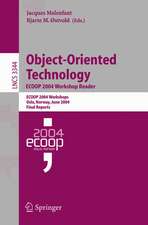Object-Oriented Metrics in Practice: Using Software Metrics to Characterize, Evaluate, and Improve the Design of Object-Oriented Systems
Autor Michele Lanza Cuvânt înainte de S. Ducasse Autor Radu Marinescuen Limba Engleză Hardback – 3 aug 2006
Lanza and Marinescu demystify the design metrics used to assess the size, quality and complexity of object-oriented software systems. Based on statistical information from many industrial projects and generally accepted semantics they deduce many single and combined threshold values. They show in detail how to identify collaboration and classification disharmony patterns in code, how to visualize their results using the freely available CodeCrawler visualization tool, and how to devise possible remedies.
The combination of theoretically sound results and practically tested procedures and solution paths makes this book an ideal companion for professional software architects, developers and quality engineers. The pattern-oriented description of disharmonies offers easy access to detecting shortcomings and applying solution strategies.
"This well-written book is an important piece of work that takes the seemingly forgotten art of object-oriented metrics to the next level in terms of relevance and usefulness." Richard C. Gronback, Chief Scientist, Borland Software Corporation.
| Toate formatele și edițiile | Preț | Express |
|---|---|---|
| Paperback (1) | 414.16 lei 6-8 săpt. | |
| Springer Berlin, Heidelberg – 12 feb 2010 | 414.16 lei 6-8 săpt. | |
| Hardback (1) | 420.89 lei 6-8 săpt. | |
| Springer Berlin, Heidelberg – 3 aug 2006 | 420.89 lei 6-8 săpt. |
Preț: 420.89 lei
Preț vechi: 526.11 lei
-20% Nou
Puncte Express: 631
Preț estimativ în valută:
80.56€ • 87.54$ • 67.72£
80.56€ • 87.54$ • 67.72£
Carte tipărită la comandă
Livrare economică 21 aprilie-05 mai
Preluare comenzi: 021 569.72.76
Specificații
ISBN-13: 9783540244295
ISBN-10: 3540244298
Pagini: 220
Ilustrații: XIV, 207 p.
Dimensiuni: 155 x 235 x 20 mm
Greutate: 0.5 kg
Ediția:2006
Editura: Springer Berlin, Heidelberg
Colecția Springer
Locul publicării:Berlin, Heidelberg, Germany
ISBN-10: 3540244298
Pagini: 220
Ilustrații: XIV, 207 p.
Dimensiuni: 155 x 235 x 20 mm
Greutate: 0.5 kg
Ediția:2006
Editura: Springer Berlin, Heidelberg
Colecția Springer
Locul publicării:Berlin, Heidelberg, Germany
Public țintă
Professional/practitionerCuprins
Facts on Measurements and Visualization.- Characterizing the Design.- Evaluating the Design.- Identity Disharmonies.- Collaboration Disharmonies.- Classification Disharmonies.
Recenzii
"This well-written book is an important piece of work that takes the seemingly forgotten art of object-oriented metrics to the next level in terms of relevance and usefulness." Richard C. Gronback, Chief Scientist, Borland Software Corporation.
Notă biografică
Michele Lanza is an Assistant Professor at the University of Lugano, Switzerland. His main research interests lie in software (re)engineering and software evolution with a special focus on software visualization and metrics. He was the creator of CodeCrawler, a freely available language-independent software visualization tool. His Ph.D. work won the Ernst Denert Software Engineering Award in 2003. Michele is a member of the ACM and IEEE.
Radu Marinescu is an Assistant Professor at the University of Timisoara, Romania. Radu’s research focuses on object-oriented reengineering and quality assurance. Several of his published research ideas have been applied in the well-known "Borland Together Control Center" CASE Tool. He also acted as a reviewer in several phases of the IEEE's SWEBOK (Software Engineering Body of Knowledge) project.
Radu Marinescu is an Assistant Professor at the University of Timisoara, Romania. Radu’s research focuses on object-oriented reengineering and quality assurance. Several of his published research ideas have been applied in the well-known "Borland Together Control Center" CASE Tool. He also acted as a reviewer in several phases of the IEEE's SWEBOK (Software Engineering Body of Knowledge) project.
Caracteristici
Comprehensive list of object-oriented disharmony patterns Many reengineering strategies for poorly structured code Brief introduction to code visualization using CodeCrawler Includes supplementary material: sn.pub/extras













